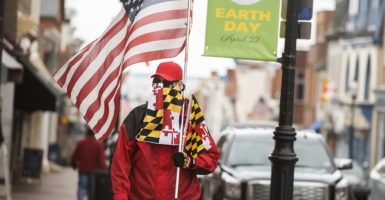Earth Day turns 50 this year, but don’t expect to see any large gatherings. The coronavirus pandemic has turned the 2020 celebration into a virtual one.
According to some observers, though, that’s a good thing. One silver lining of COVID-19, they point out, is a healthier environment.
Without a doubt, quarantining is yielding environmental improvements. Driving and flying have dropped considerably. According to satellite imagery from NASA, nitrogen dioxide, carbon monoxide, and other emissions are down. The canals in Venice are cleaner, and people in certain parts of India can see the peaks of the Himalayas for the first time in years.
>>> When can America reopen? The National Coronavirus Recovery Commission, a project of The Heritage Foundation, is gathering America’s top thinkers together to figure that out. Learn more here.
These environmental benefits certainly sound encouraging. But they raise the question: At what cost?
Millions of people are stuck at home worrying about their finances. Small business owners are wondering if and when they’ll be able to reopen their doors—and pay their workers.
Schools have closed for the year. College and high school graduations are canceled. Anxiety and isolation have replaced many of our most basic activities.
Granted, the human species is a resilient bunch. People have found countless ways to educate, entertain, and stay positive. But do we really want to associate environmental progress with a worldwide pandemic and off-the-charts amounts of human suffering—both physical and financial?
Many people would gladly trade the ability to earn a living, and the opportunity to take care of family members, for the amount of pollution we reduced over the past few weeks. If anything, it should serve as a reminder that the environmental byproducts we produce when we travel to work or to visit our families over the holidays—and still breathe fresh air—is worth it.
Of course, that is not true everywhere. Poor air quality is a real concern in developing countries like China and India. But so are accessing basic necessities, such as access to affordable, reliable electricity.
In India, for example, and other places where temperatures can be sweltering, a sign of economic and social mobility is being able to afford an air conditioner. In other parts of the world, countries are making trade-offs by prioritizing economic well-being over the environment.
The solution to better air and water quality, however, is not to trap the world’s poorest people in poverty. Rather, it is to ensure people can achieve better standards of living of higher levels of wealth so they have the means to live a better life and also devote resources toward environmental protection.
And as we devote resources to environmental protection, it’s important to remember the law of diminishing returns.
For instance, think about cleaning your house. At first, there are noticeable gains from picking up, vacuuming, and dusting. At a point, though, the cost of effort in cleaning isn’t worth the benefit you’ll receive. You’re not about to move the fridge every day to get the dust and crumbs in the back corner of your kitchen.
The same holds true for the costs and benefits of environmental regulation. In many instances in the United States, the higher prices households and businesses pay for more stringent standards have negligible environmental benefits.
Similarly, the trade-off isn’t worth it.
America’s strong environmental record is not to suggest, however, that we should be happy with the status quo. Rather than considering the trade-offs between economic growth and environmental progress, let’s improve upon the ways where they go hand in hand. Innovators are continually seeking out ways to introduce new technologies that have smaller environmental footprints.
Businesses and individuals have a financial motivation to do more with less. Beverage manufacturers have significantly reduced the amount of plastic for bottled water and soda and are now manufacturing bottles partly from plants. Grocery stores and office buildings use energy-efficient lights and install motion-activated lights in less trafficked areas to cut costs.
And there’s a reason parents tell their kids to turn off the lights when they leave the room or to close the door. Because money doesn’t grow on trees. The economic incentive that drives these decisions also generates better environmental outcomes.
Many lessons learned will come from living in a coronavirus world. As a grand experiment, it may prove to help better understand the relationship between the global economic engine and the environmental byproducts that engine produces.
But it should also give us a sense of appreciation as Americans to live in a world where we can use a great deal of energy and breathe comfortably. And when we reopen the doors to economic activity, we can harness human ingenuity to make our lives more enjoyable and our environment healthier.
Originally published in The Baltimore Sun





























